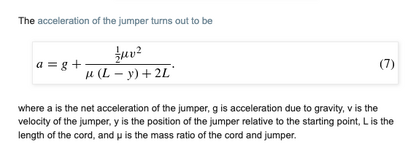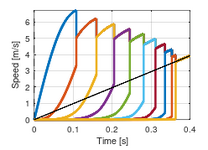-
1
- #1
GregLocock
Automotive
- Apr 10, 2001
- 23,761
Never seen the attraction myself, but this paper investigates why a bungee jumper accelerates at more than 1g
Good stuff.
Good stuff.
Follow along with the video below to see how to install our site as a web app on your home screen.
Note: This feature may not be available in some browsers.
Like, "Push with a rope"?
How can a falling cord exert a force on a body to accelerate the body at grater than 1 g unless the falling cord is falling at more than one g?So, the bungie cord is pushing upwards on the jumper?
The OP's article ignores any stretch in the bungee cord in their analysis. So it should be the same for a rope.Another factor.
Thanks Mint.
Would that add to the acceleration?
(I will have to put old boring reruns on TV tonight and bore myself to sleep.
Else I will be awake all night trying to figure this out.
Nite all.

I can't make the equations for that in my mind yet.stretched Slinky being dropped.


How can a falling cord exert a force on a body to accelerate the body at grater than 1 g unless the falling cord is falling at more than one g?
